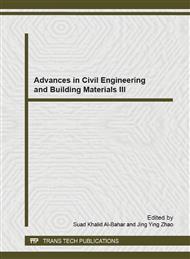p.105
p.110
p.115
p.120
p.124
p.129
p.133
p.137
p.141
Comparison of Wind Pressure Coefficients with Wind Load Provisions
Abstract:
This study has compared the equivalent external pressure coefficients, (GCpf)eq, with 6 wind load provisions and wind tunnel test data. The wind load provisions are the ASCE 7-10, NBCC 2010, AS/NZS 2011, EN 2005, AIJ 2004 and KBC 2009. Experiment data on low-rise building have been obtained at the University of Western Ontario (UWO) to contribute to the NIST aerodynamic database [. For the experiment, a model with 1:12 of roof slope and 4.9 and 12.2m of eave height was used under open terrain conditions (See also Ref. [). (GCpf)eq was re-normalized based on the external pressure coefficients, GCpf, of ASCE 7-10. When compared to (GCpf)eq of the experiment data with 4.9m of eave height, consequently, ASCE 7-10 (81%), NBCC 2010 (84%), AS/NZS 2011 (70%), AIJ 2004 (68%) and KBC 2009 (53%) were all underestimated. Among them, KBC 2009 reveals the lowest value. On the contrary, EN2005 was overestimated with 122%. When the eave height was 12.2m, in addition, the same pattern was observed in most codes. EN2005 was slightly overestimated with 115%.
Info:
Periodical:
Pages:
124-128
Citation:
Online since:
December 2013
Authors:
Price:
Сopyright:
© 2014 Trans Tech Publications Ltd. All Rights Reserved
Share:
Citation:


